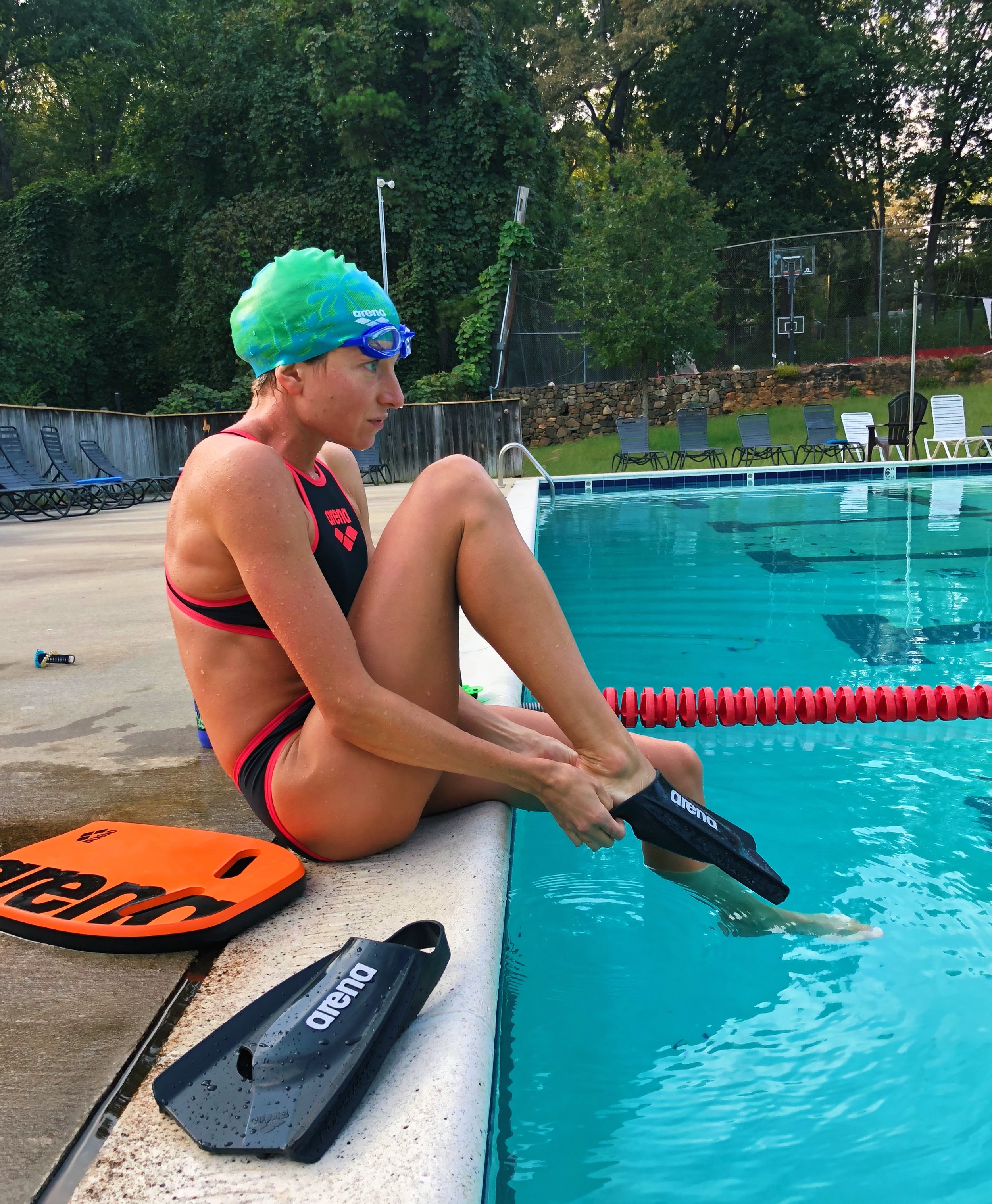How to Use Pool Running and Swimming for Cross-Training
My first sport was swimming, and for this, I am always thankful. You can only do so many miles on the road, but it’s a lot harder to beat up your body while you’re helpfully suspended by water in the pool. I’ve always been glad I have the water as a way to add in extra cardio without the extra pounding, and that I know what to do in a pool. However, a lot of runners are used to exclusive land training, so here are some tips to help you dive into the water smoothly and successfully.
Pool Running
I have seen some really horrific pool running form over the years. Granted, you’re still probably getting something out of this no matter what your form looks like, but you’re going to get more out of your pool time with a few adjustments so that your time here translates more accurately to real running.
1. Pool running does NOT actually resemble land running. One mistake runners make is that they try to make their pool running resemble their form on land. Instead of this, aim for more of a stomping motion, where you drive the knees up and down and press through the ball of your foot on the down stroke. Good pool running is much less about your foot moving forward and backwards, and much more about moving your foot up and down.
2. Remember it doesn’t actually matter how fast you travel down your lane while pool running. Instead, focus on leg cadence. It’s also much easier to think about quick leg cadence with proper form as described above.
3. Use a pool belt. It helps you have proper form! Yes, it might be harder without the belt, but you’re not going to be able to focus on your form and leg turnover as much—instead you’ll just be thinking about keeping your head above water.
In addition to these three main tips, I also recommend doing different leg movements and speeds to make your workout more interesting.
1. Mix up your movement. At the risk of sounding contradictory to point 1 above, try doing just a flutter kick movement underwater for spurts of 15-30 seconds every 5 minutes or so, or whenever you feel like your legs just need to move in a different manner. This means much less of a knee bend: you’re aiming for a kick like what you’d use when swimming freestyle. (In essence, this is vertical kicking for those of you familiar with swimming terminology.) For these breaks of vertical kicking, try lifting your hands or even your elbows out of the water to make this more challenging. You’ll likely find you are relieved to be back to the regular pool running “gait”!
2. Fartleks are a pool runner’s best friend. Anything you can do to break up the monotony of pool running will help you to get a better workout. You can do really any type of fartlek like what you’d do on land. Here are a few examples:
Workout A: (40 min. total. Each round is 5 min. Shorten the warmup or cooldown or do fewer rounds to adjust the overall time.)
10 min. warmup, then
4 rounds of:
1min. hard, 1 min. easy,
:90 hard, :90 easy
10 min. of regular pace
Workout B: (40 min. total, each round is 10 min. so eliminate one for a shorter workout or adjust warmup/cooldown time)
10 min. warmup,
2 rounds:
1 min. hard, :30 easy,
2 min. hard, 1 min. easy,
3 min. hard, 1:30 easy
:30 hard, :30 easy
10 min. cooldown
3. If possible, bring company! I used to wish that pools would show movies so I wouldn’t die of boredom while pool running alone. Even better is to bring good company with you. When I have company, I usually just pool run without a workout—I find that I have no problem focusing and getting a good length workout in if I just have a friend there!
Swimming
Fins are a great way to use your legs a little more in the pool or to keep going for a little longer.
Ah, swimming! I can’t tell you the number of times I have thanked the Lord for my ability to swim. I only learned to swim at age 11, which is quite late for a competitive swimmer, but I immediately loved it. I used to want to swim in college, and could have gone DII or III, but I chose running at DI. I’m glad I did, but I’m also glad I kept up my swimming throughout my college running days regardless. I’m hoping to do more triathlons in the future (and only wish the bike portion were nonexistent!). Here are a few ways for a runner who is currently not a swimmer to venture into swim workouts (which I find far more interesting than pool running, FYI…I could swim all day!).
A very general, beginner’s breakdown of how to do a swim workout:
Start small and break it up. If you were ever on a swim team, you know the object is not just to hop in the pool and do as many laps as you can possibly do. Instead, you do a set numbers of laps on different time intervals. Pay attention to the time clock. (If you’re at a good pool, there will/should be a good clock on display with the seconds clearly visible wherever you are in the water. If your pool doesn’t have this, use your watch, but this will be a lot harder visibility-wise….so, find a better pool!) Then, figure out how long it takes you to do a 50 (2 laps, or down and back, assuming your pool is standard short course yards or meters) while just going at a moderate speed. Use this as your base pace. Round to the nearest :05 or :10 so you aren’t stuck doing a lot of complex math! Alternatively, you can just do your intervals based on your rest at the wall, which is what I’ve done for the below example workouts. So for instance, if you base your workout on your rest time, you can do X number of laps, then rest :10 on the wall, then repeat this a certain number of rounds. Using this kind of rhythm, you can then start to figure out how to do a good swim workout. Here are some very easy, beginner examples:
Invest in your own kickboard if you’re going to be at the pool a lot.
Note that FR = freestyle, BK = backstroke here.
Workout A: (1000 yards)
100 swim, :10 rest
100 kick, :10 rest
100 pull, :10 rest
2 rounds:
3 x 50 FR descend 1-3 (meaning, you get faster with each 50 until you’re sprinting the last one) on :10
50 easy recovery
2x100 (25 kick, 50 FR, 25 kick), first 50 is moderate, second 50 is fast
100 easy
Workout B: (1500 yards)
500 swim: 25 FR, 25 BK, 50 FR, 50 BK, 75 FR, 75 BK, 100 FR, 100 BK, rest :30
500 kick, same as above, rest :30
4 rounds:
25 kick underwater on :05 rest
25 FR fast on :05 rest
200 pull, 2nd and 4th 50s are fast
100 easy
You have to do workouts that you love to be a successful, happy athlete. I love the pool so I use it a lot! Try it and see how it goes for you! In addition to being an easy way to add in extra cardio, the pool itself is an excellent recovery tool—I find being in the water very therapeutic in and of itself.





